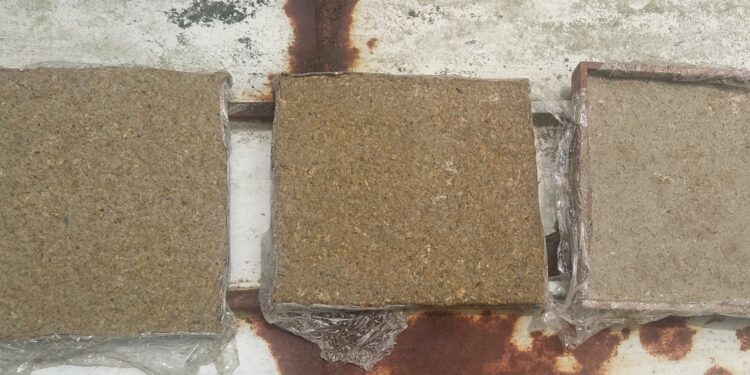Three composition panels tested. Credit: Universidad Tecnológica de Panama, Grupo de Investigación: Iniciativa de Integración de Tecnologías para el Desarrollo de Soluciones Ingenieriles (I2TEDSI)
The construction sector is the second largest consuming sector of plastic and is responsible for more than a third of energy-related greenhouse gas emissions worldwide. Manufacturing processes for building materials pollute air, land and water. Thus, construction materials made from agro-industrial waste are becoming more and more attractive due to their lower environmental impact.
To contribute to a new generation of materials made from what is often considered waste, Panamanian researchers developed an insulating material based on rice husk and evaluated its thermal and mechanical properties. They published their results in Boundaries in the Built Environment.
“Here we show that it is possible to create an alternative insulating material from recycled newspapers and rice husks,” said Dr. Nacarí Marín Calvo, researcher at the Universidad Tecnológica de Panamá, Centro Regional de Azuero and first author of the article. “The developed material has competitive thermal conductivity compared to many natural and recycled insulating materials.”
A four-ingredient recipe
In rural Panama, where the study was conducted, rice husk is considered an agricultural waste, normally landfilled or incinerated, making it a significant environmental concern. To produce the mixture, the hulls were shredded. Then cellulose, obtained from recycled and shredded newspapers, was added, followed by borax, which made the mixture resistant to fungus and gave it flame-retardant properties. All components were glued together with glue.
The researchers tested different material compositions to check how the material behaved when more or less rice husk was used. The first mixture consisted of 14% newspaper, 9% rice husk, 15% borax and 62% glue. In the other two compositions, the quantity of rice husk was increased, while the quantity of newspaper was decreased. The quantities of borax and glue remained unchanged. “We found that the results were similar in all three compositions in terms of k-values, maximum stresses and compressive strength values,” said Marín Calvo.

Samples from tensile strength tests. Credit: Universidad Tecnológica de Panama, Grupo de Investigación: Iniciativa de Integración de Tecnologías para el Desarrollo de Soluciones Ingenieriles (I2TEDSI)
Face to face with other natural materials
Thermal conductivity, also often called k-value, describes a material’s ability to conduct heat. A lower value means the material is more suitable for insulation. For the tested compositions, the k value was between 0.0409 and 0.04607 watts per Kelvin meter (W/mK). Other natural and recycled insulation materials have k-values ranging from 0.027 to 0.1 W/m/K.
Tensile strength is the maximum stress a material can withstand when stretched or pulled before breaking. Tests showed that the maximum average tension stress varied between 1.31 and 1.76 megapascals (MPa) for the three compositions. Pascal is the unit used to measure the force applied in a 90° angle on the surface of an object. Materials based on cardboard, cement and sand have similar tensile strength values.
The compressive strength values obtained were between 20.19 and 21.23 MPa. Compressive strength describes a material’s ability to withstand pressure. The values obtained allowed the researchers to verify the possibility of using the developed material in construction applications.

Temperature measurement. Credit: Universidad Tecnológica de Panama, Grupo de Investigación: Iniciativa de Integración de Tecnologías para el Desarrollo de Soluciones Ingenieriles (I2TEDSI)
Beyond construction
The researchers stressed that in the future, more studies would be needed to confirm the material’s insulating properties and how it withstands climates different from Panama, where humidity is high. “As part of future research, we evaluate the degradation of the grown material under controlled ambient conditions,” said Marín Calvo.
Further research could also include other configurations, such as adding long fibers pointing in one direction to strengthen the tensile behavior of the material. “We can conclude that the material could also be used in various engineering fields, including the production of lightweight components, construction panels and sustainable packaging,” concluded Marín Calvo.
More information:
Thermal insulation material produced from recycled materials for applications in construction: Material based on cellulose and rice husk, Boundaries in the Built Environment (2023). DOI: 10.3389/fbuil.2023.1271317
Quote: Rice husk and recycled newspapers could be the ecological insulating material of the future (November 30, 2023) retrieved on November 30, 2023 from
This document is subject to copyright. Except for fair use for private study or research purposes, no part may be reproduced without written permission. The content is provided for information only.



